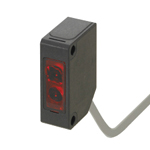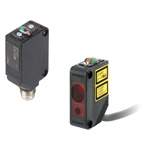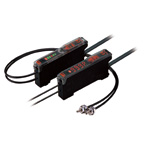(!) Since support from Microsoft will end on January 14 2020, Windows 7 user might not be able to use MISUMI website effectively. Please consider to update your system as ‘MISUMI Website system requirement’.
- แจ้งวันหยุดทำการในเดือน กรกฎาคมและสิงหาคม 2567 | Notice holiday in July and August 2024 > คลิก
MISUMI Photoelectric Sensors, Fiber Sensors
Photoelectric Sensors, Fiber Sensors products in the Automation Components category from MISUMI. The product can be selected based on many product specifications such as Detection Distance, Detection Type. MISUMI offers products around 1 items and the product specifications can easily be compared. Search and select detailed specifications of parts for your machine with free CAD downloads. MISUMI products are available to order through MISUMI online 24 hours a day. Free shipping, no minimum order.
Search by specifying the lower class category
Configure
Specification/Dimensions
-
Detection Distance(mm)
- 0-3M
- 0~4
- 0~15
- 0.1-3m
- 0.1-2.5m
- 1,000
- 1~15
- 1~30
- 2~6
- 3~50
- 5
- 5~15
- 5~30
- 5.4~9
- 6
- 8~20
- 10
- 10 ± 2
- 10~20
- 10~250
- 12
- 12~30
- 15
- 15m
- 15~38
- 16
- 17
- 20~100mm
- 27
- 30
- 30±3
- 30 ± 5
- 30~200
- 30~300
- 35 ± 5
- 35~200mm
- 50
- 50~3000
- 60
- 70 ± 10
- 100
- 100mm
- 110
- 120
- 130
- 140
- 150
- 150~1500
- 180
- 190
- 200
- 200-3,000
- 220
- 250
- 280
- 300
- 300mm
- 350
- 360
- 400
- 450
- 500
- 550
- 600
- 680
- 800
- 900
- 1000
- 1100
- 1200
- 1350
- 1500
- 1550
- 1700
- 1780
- 1800
- 2000
- 2000mm
- 2600
- 2700
- 2800
- 3000
- 3500
- 3800
- 4000
- 5000
- 20000
- 30000
- 40000
The detecting distance can vary with your amplifier, operating environment and the detected object.
-
Type
- Photoelectric Sensor
- Laser Sensor
- Fiber Unit
- Fiber Sensor (Amplifier)
- Lens for Sensor
- Fiber Optic Sensor
-
Detection Type
- Transparent
- Reflection
- Liquid Surface Contact
- Recurrent Reflection
-
Light Axis Arrangement Type
- Emitting and Receiving Sections Integrated, Single
- Emitting and Receiving Sections Integrated, Reflection Plate Used
- Emitting and Receiving Sections Separated
-
Head Shape
-
Detection Light Type
-
Detection Object
- Colored Surface
- Transparent Body
- Mirror Surface Body
- Small Area
- Thin Line Shape
- Liquid Surface (Pipe Mounting)
- Liquid Surface (Contacting)
- Wafer Mapping
- Label
-
Amplifier Installation Type
- Built-in Type
- Separated Type
- Amplifier Only
-
Detection Light Color
-
Head Material
-
Detection distance 【classification】(mm)
- ~10
- ~20
- ~30
- ~50
- ~100
- ~200
- ~300
- ~400
- ~500
- ~1000
- ~2000
- ~3000
- ~4000
- ~5000
- ~10000
- More than 10000
* ~20 represents over 10, and 20 or less.
-
Operating Environment
-
Protection Structure
-
Amplifier Function (Selectable only when Amplifier is installed)
-
Fiber Type (Selectable only when Amplifier is not installed)
-
Fiber clothing material
-
Fiber minimum bend R(mm)
Brand |
|
|---|---|
| CAD |
|
- 1 items
- Sort By
-
RecommendedYou can add up to 6 items per a category to the compare list.




 Economy-series general-purpose area sensor has a compact appearance and is suitable for the protection of various automation equipment.It also has the advantages of high precision and long shooting distance.
Economy-series general-purpose area sensor has a compact appearance and is suitable for the protection of various automation equipment.It also has the advantages of high precision and long shooting distance.
The output adopts an independent dual-loop output control method and has safety self-inspection and mutual inspection functions.
Small appearance size, cross-sectional size 35*27mm. It adopts an independent dual-loop output control method, which is safe and reliable.
Short response time, the fastest response time is <1ms.
Wide voltage power supply DC24±20%.
Strong anti-electromagnetic interference ability, which can effectively resist various electromagnetic interference effects of motor equipment.
It adopts line synchronization technology and has strong anti-light interference ability. It is easy to install and simple to operate.From: ฿ 1,841.25 Days to Ship: 8 Day(s)
8 Day(s)
| Brand |
|---|
| Product Series |
| CAD |
| From |
| Days to Ship |
| Detection Distance(mm) |
| Type |
| Detection Type |
| Light Axis Arrangement Type |
| Head Shape |
| Detection Light Type |
| Detection Object |
| Amplifier Installation Type |
| Detection Light Color |
| Head Material |
| Detection distance 【classification】(mm) |
| Operating Environment |
| Protection Structure |
| Amplifier Function (Selectable only when Amplifier is installed) |
| Fiber Type (Selectable only when Amplifier is not installed) |
| Fiber clothing material |
| Fiber minimum bend R(mm) |
You can add up to 6 items per a category to the compare list. | |
| Brand | |
| Product Series | |
| CAD |
|
| From | ฿ 1,841.25 |
| Days to Ship | 8 Day(s) |
| Detection Distance(mm) | 0.1-3m |
| Type | - |
| Detection Type | Recurrent Reflection |
| Light Axis Arrangement Type | - |
| Head Shape | - |
| Detection Light Type | - |
| Detection Object | - |
| Amplifier Installation Type | - |
| Detection Light Color | - |
| Head Material | - |
| Detection distance 【classification】(mm) | - |
| Operating Environment | - |
| Protection Structure | - |
| Amplifier Function (Selectable only when Amplifier is installed) | - |
| Fiber Type (Selectable only when Amplifier is not installed) | - |
| Fiber clothing material | - |
| Fiber minimum bend R(mm) | - |
Loading...
Application example related to this category
Related Categories to Photoelectric Sensors, Fiber Sensors
FAQ Photoelectric Sensors, Fiber Sensors
- Question: What is the main advantage of using photoelectric sensors in industrial applications?
- Answer: Photoelectric sensors offer a significant advantage in industrial settings due to their non-contact detection capability. This feature eliminates the need for physical contact with the target object, reducing wear and tear and enabling reliable, long-term operation. Their quick response time is crucial for applications requiring rapid detection, contributing to increased efficiency in various industrial processes.
- Question: How do I choose the right photoelectric sensor?
- Answer: Selecting the appropriate photoelectric sensor involves considering several factors. Evaluate the sensing distance required for your application, environmental conditions, such as ambient light and temperature, and the characteristics of the target objects. Differentiate between through-beam, reflective, and retroreflective sensors based on the specific needs of your application.
- Question: Can these sensors be used in outdoor environments?
- Answer: Some photoelectric sensors are designed for outdoor use. It's essential to choose sensors with suitable Ingress Protection (IP) ratings to ensure they can withstand exposure to weather elements and maintain reliable performance.
- Question: What is the difference between a through-beam sensor and a reflective sensor?
- Answer: Through-beam sensors consist of separate emitter and receiver units, with the light beam traveling from one unit to the other. In contrast, reflective sensors integrate both the emitter and receiver in the same housing, detecting the light reflected off a target object.
- Question: Can photoelectric sensors detect transparent or highly reflective objects?
- Answer: Certain photoelectric sensors are specifically engineered to detect transparent or highly reflective objects. Choosing sensors with the appropriate technology, such as background suppression or polarization filters, ensures accurate detection in challenging conditions.
- Question: What maintenance do photoelectric sensors require?
- Answer: Photoelectric sensors typically demand minimal maintenance. Regularly cleaning the sensor lens to prevent the accumulation of dust or dirt is recommended to ensure consistent and accurate performance over time.
- Question: Are there any safety considerations when using photoelectric sensors?
- Answer: When using photoelectric sensors, it's crucial to ensure compliance with relevant safety standards. Installation should follow the manufacturer's guidelines, and users should be aware of the sensor's limitations. For critical applications, incorporating redundancy or additional safety measures is advisable to mitigate potential risks.






























How can we improve?
How can we improve?